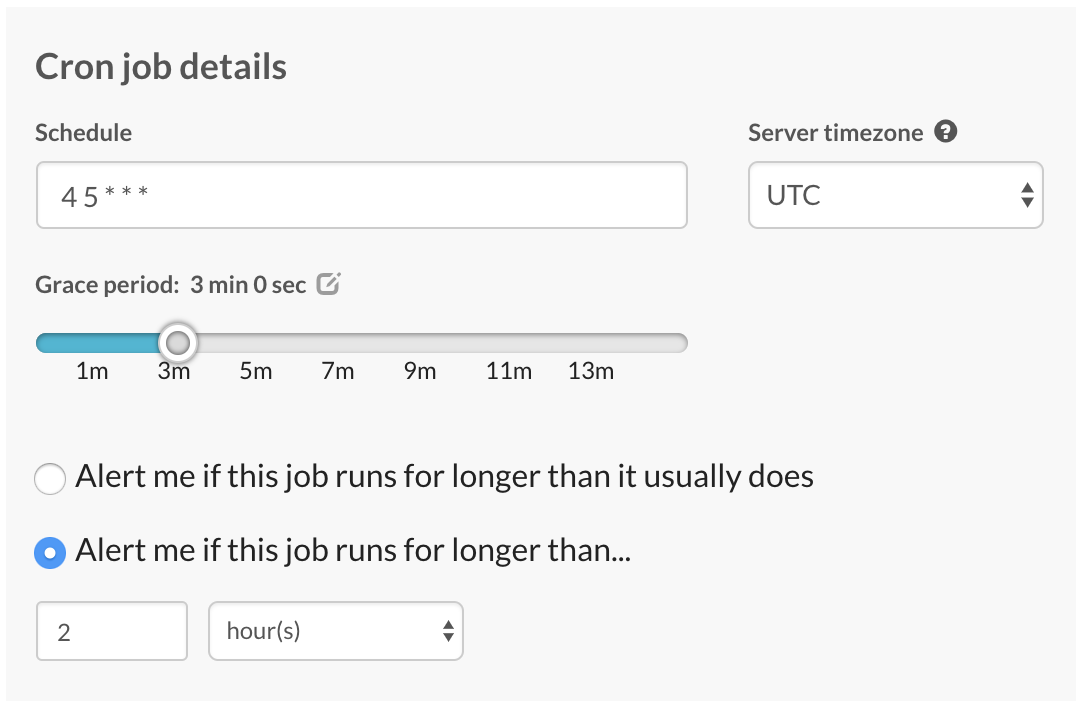Cron Job Time Tracking
Cronitor will alert you if your job runs longer than expected. These alerts provide value beyond simple pass/fail alerts, for example:
- System resource planning. As you accumulate new scheduled jobs, it can be difficult to predict if and when running jobs will overlap. With only a few jobs, you're able to schedule them far enough apart that one should be done before the next starts. But as time goes on and the performance characteristics of your jobs change, cron scheduling becomes a moving target.
- Monitoring performance creep. It's an issue many people can relate to. You've configured a cron job that runs as quickly as expected, only to see that performance deteriorate over time as your database gets bigger or your customer list grows longer. Often this happens unnoticed, out of sight, until your once-per-hour job starts taking more than an hour to run.
How duration alerts work
To send duration alerts, Cronitor must know when your job starts running and when it completes successfully. To
report these events, you should ping your /run endpoint as your job starts and your /complete
endpoint when it completes. If you are using CronitorCLI exec this is done for you automatically. For more details on ping URL endpoints and where you should integrate your ping requests,
see:
With /run and /complete pings, Cronitor is able to calculate an expected duration range for your job.
The predictions grow more accurate as we learn more about your job performance but will not work perfectly for every job. If it's normal for job runtime to vary significantly,
or if you are receiving has not completed alerts earlier than you would like, you can provide a fixed runtime duration:

Understanding When Alerts are Sent
To evaluate the runtime duration of a monitor, we start a timer when you ping your /run endpoint and send an alert if
your defined threshold is reached before a /complete ping is received. For example if you create a monitor with a 5 minute expected duration and your task pings /run
at 06:00, then dies due to a database connection failure, your alert will be triggered after 06:05. We usually send
alerts within 1 minute of failure.
A "ran less than" rule is also available on heartbeat monitors that can alert you if a task finishes too quickly. This rule is not evaluated until we receive a /run ping and subsequent /complete ping. In most cases
your rule is evaluated within 1 minute of your /complete ping.
Troubleshooting manual integration
-
If you receive unexpected alerts for a new monitor, review your ping history from the dashboard to ensure it matches your expectations. If there are missing pings, double check
your integration. Verify that you are pinging the
/runendpoint before your job and your/completeendpoint after. A missing or misplaced/runor/completeping is the most common integration mistake. -
If you've verified that you're pinging
/runand/completeappropriately, try changing the logic in your commands from&&"and" logic to;"or" logic.Switch from only pinging
/completeif your command finishes successfully:* */2 * * * curl -m 10 https://cronitor.link/d3x0/run ; /path/to/db_backup.sh && curl -m 10 https://cronitor.link/d3x0/complete
To always pinging
/complete:* */2 * * * curl -m 10 https://cronitor.link/d3x0/run ; /path/to/db_backup.sh ; curl -m 10 https://cronitor.link/d3x0/complete
By changing to
;you will ping your Cronitor URL even if your command exits with a non-0 exit code. If this works, you should investigate why your command is exiting with an error code.